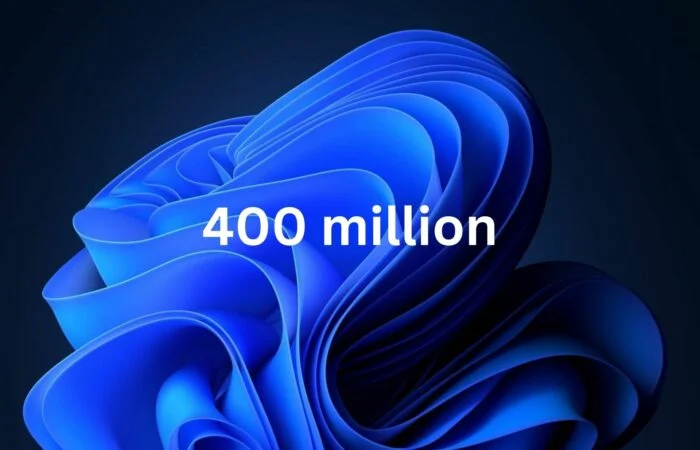In an intriguing turn of events, Microsoft’s Windows 11, the latest entrant in the Windows OS family, is approaching a significant milestone, with nearly 400 million devices under its purview. While the figures are impressive, they also shed light on a somewhat unexpected trend – Windows 11’s growth trajectory is notably slower than that of its predecessor, Windows 10. In this report, we’ll delve into the numbers, the underlying reasons, and what the future holds for Microsoft’s operating systems.
A Slower Climb for Windows 11:
The unveiling of Windows 11 back in October 2021 was met with excitement due to its fresh design and enhanced features. Yet, the path to user adoption has been marked by a significant divergence from the speedy ascent witnessed during Windows 10’s heyday.
The facts speak for themselves. Windows 10 achieved a remarkable feat by reaching 400 million active devices within just over a year after its release. In contrast, Windows 11 has taken a more leisurely two-year journey to cross the same milestone, raising questions about the reasons behind this deceleration.
Strict Hardware Requirements a Key Player:
One of the prominent factors contributing to Windows 11’s relatively sluggish adoption is its stringent hardware prerequisites. Windows 11 has chosen to be selective in its choice of companions, favoring CPUs released from 2018 onwards and necessitating devices equipped with Trusted Platform Module (TPM) security chips. This adjustment in minimum system requirements was aimed at elevating security standards within Windows 11, leveraging modern chips capable of enabling advanced security features.
However, these stringent hardware demands have seemingly put a damper on the operating system’s uptake. Windows 10, in contrast, was more inclusive, extending a free upgrade to users of Windows 7 and Windows 8. Windows 11, on the other hand, provided complimentary upgrades exclusively to those Windows 10 users who met these stringent hardware standards, leaving numerous devices excluded from the transition.
ALSO READ: Microsoft Paint Gets a Boost: Say Hello to Layers and Transparency
The Data Paints a Clear Picture:
The disparity in adoption rates becomes even more apparent when examining available data. Steam survey results reveal that Windows 11 presently constitutes just 37 percent of operating systems, while Windows 10 continues to command nearly 60 percent. A deeper dive into Statcounter’s market share data illustrates Windows 11’s current share, hovering at approximately 25 percent, while Windows 10 retains a substantial majority, with over 70 percent.
Microsoft’s Tight-Lipped Approach:
An additional factor adding complexity to the narrative is Microsoft’s reticence regarding the exact count of active devices running Windows 11. The company had previously disclosed combined data for Windows 10 and Windows 11 on its “Microsoft by the numbers” page, but this practice was discreetly discontinued last year. A cached page from April 2022 revealed more than 1.4 billion monthly active devices running either Windows 10 or Windows 11.
Based on Microsoft’s own figures, Windows 11 appears to represent almost 30 percent of Windows usage, with Windows 10 still serving nearly 1 billion users. Notably, Microsoft accomplished its goal of reaching 1 billion devices running Windows 10 in March 2020, a substantial 18 months ahead of Windows 11’s debut.
A Critical Deadline on the Horizon:
Looking ahead, there’s a critical deadline for Windows 10 looming on October 14, 2025, when Microsoft will cease to provide security updates and fixes for millions of machines still running Windows 10. Convincing more businesses and consumers to transition to Windows 11, or any potential successor, before this deadline will be imperative. Failure to do so could necessitate an extension of the support cutoff date.

Windows 12: The Next Frontier:
Amid these developments, there’s anticipation surrounding the potential release of Windows 12 in 2024. Intel recently teased a “Windows refresh” for the same year, aiming to boost their revenues. Clues about Windows 12 have surfaced through leaked references in internal Intel documents, although Microsoft has yet to officially announce their plans for this next iteration.
ALSO READ: Xbox Cloud Hybrid Games: Microsoft’s Vision for the Future of Gaming
What makes the prospect of Windows 12 intriguing is the focus on artificial intelligence (AI). Microsoft’s Yusuf Mehdi, the head of consumer marketing, has hinted at the integration of AI into the future Windows experience, suggesting a path toward more innovative and intuitive computing.
In summary, Windows 11’s journey has been characterized by steady but slower growth, largely attributed to stringent hardware requirements. With Windows 10’s support scheduled to end in 2025, Microsoft faces the challenge of persuading users to make the transition, a task that could impact the extended support deadline. The upcoming Windows 12 adds a layer of anticipation, promising an exciting future marked by AI-driven advancements.









